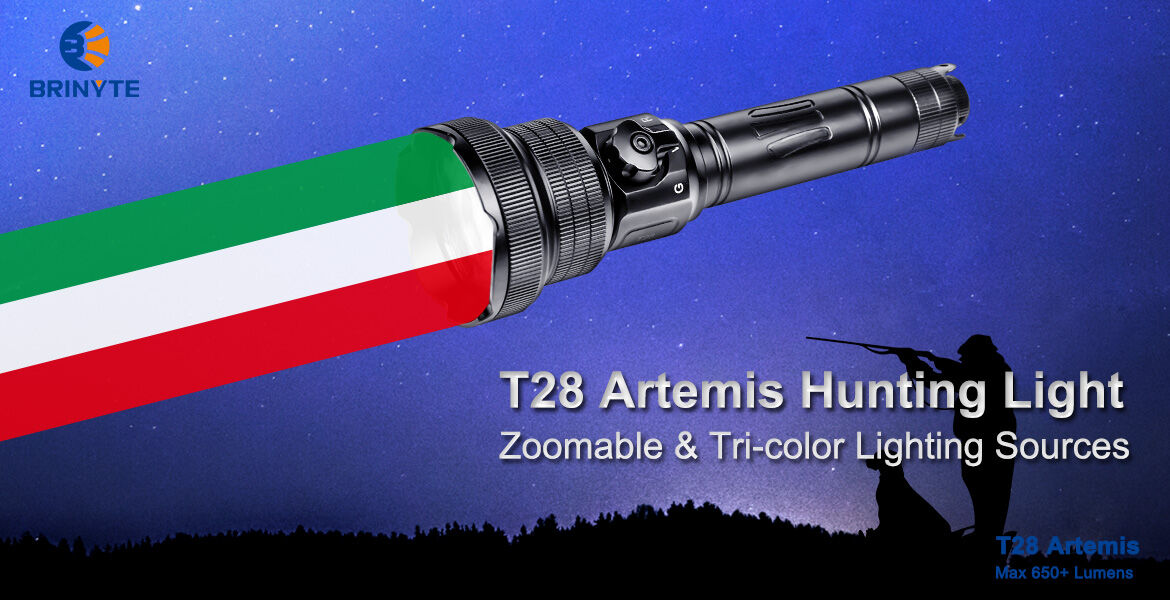Introduction
Despite living in an age of rapid scientific and technological advancement, there is actually very little innovation going on. Companies focus more on marketing than research and development and "new" products seem more like copies of each other than developed and designed with the needs of the consumer in mind.
As a reviewer I enjoy seeing products with true innovation, products that were developed with some actual thought in the design process. Such is the Brinyte T28 Artemis that Brinyte sent me to review.
The Brinyte T28 Artemis is a hunting light and its design and function are specifically tailored for the job. With an interface that is intuitive and easy to use -with or without gloves- and a triple light source (white, red, and green) without the need to carry extra filters, the Brinyte T28 Artemis is the most complete hunting light anyone could wish for.
Does that mean it is perfect? Well, nothing is and I do not expect this light to be the exception. But let's delve into the review and find out if Brinyte did justice to Artemis, the ancient Greek goddess of hunting.
Unboxing
I received the review sample in a plain cardboard box, but that is not what the consumer gets, as the Brinyte T28 Artemis normally comes in a nice retail package.
Inside the box there is a comprehensive instruction manual, laid out on 3 cards, which are held together with a nice hook and lanyard.
There are also some spare o-rings and a USB type-A to type-C charging cable, which is long enough to comfortably set the battery on a table while charging it and not have it hanging from the socket, as might be the case with the cables some other manufacturers provide.
As this is a light that can be mounted on a riffle with the appropriate mount (not included), a remote switch is included in the box. The remote switch replaces the tail cap of the light, has a spiral cable and includes a button to power on or off and separate buttons for increasing or decreasing brightness.
The back of the switch has an adhesive-backed Velcro patch, so the switch can be mounted and removed freely.
The cable has a stress relief, to avoid damage from movement. The conducting spring is not particularly thick, but it should be sufficient, since the battery is only subjected to modest power draw.
Last but not least, the star of the show, the light itself. A lanyard comes pre-attached to the tail of the light. The lanyard is of nice quality but I would prefer it to be adjustable and have a sturdier tying end.
The aesthetics of the light are nice and seem to be permeated by a faint military air, in a modern way. The anodization is flawless and there are no sharp edges anywhere.
The light can tail stand, but I would not trust it as the head is a lot wider than the tail. Headstands are a lot safer, and the crenellated bezel ensures you can see if the light is on.
The battery ships safely inside the light casing, with one of its terminals insulated by a tab.
The battery is a 21700 Brinyte branded and claims a capacity of 5000mAh. It has a USB C port near the positive terminal and can be directly charged with the provided cable and a charger.
The Brinyte T28 Artemis features a spring on the driver end as well as the tail cap. This ensures the light will not turn off if bumped, as pressure is applied on both ends of the battery. The springs are similar to the one on the remote switch, nice quality but not thick.
This is how the light looks with the remote switch installed.
Quality
There is not much to say about the quality of the Brinyte T28 Artemis. The fit and finish is as good as I have seen in any production light. The anodization is flawless and the controls are responsive and sturdy.
The threads are nicely cut and even though thicker springs are always nice to have, if the light is not drawing much current they do not make an important difference.
The lanyard could (and should) be adjustable and with a thicker tying end, but that is not a major complaint as it is replaceable.
Specifications
The features and technical parameters of the Brinyte T28 Artemis, as found on the manufacturer's website, are the following:
FEATURING
· Powered by one 21700 rechargeable Li-ion battery
· Brinyte patented tri-color lighting sources switch design
· Rotating head to zoom in and out the beam
· Tail stepless dimmer switch design, easy to meet any brightness requirements
· Threaded lens for more effective concentrating effect
· Regulated power supply maintains constant brightness
· Overcharge, over-discharge and overheat protection
· Reverse polarity protection prevents damage from improper battery installation
· Aircraft-grade high strength aluminum AL-6061-T6 with premium Type III military hard-anodized anti-abrasive finish
TECHNICAL PARAMETERS
|
ANSI/NEMA FL1 |
Turbo(White) |
Turbo(Red) |
Turbo(Green) |
|
Output(Flood/Spot) |
650+/360+Lumens |
140+/55+Lumens |
130+/70+Lumens |
|
Max Runtime |
135mins |
220mins |
270mins |
|
Beam Distance |
525+m/572+yds |
255+m/277+yds |
340+m/370+yds |
|
Intensity |
69600+cd |
16480+cd |
29160+cd |
|
Impact Resistant |
1m/1.09yds |
||
|
Protection Proof |
IP66 |
||
|
Working Voltage |
3.0-4.2V |
||
|
Dimension |
182~196mm(Length) x 25.4mm(Body Dia) x 54mm(Head Dia) |
||
|
Net Weight |
200g/7.05oz (excluding battery) |
||
Unfortunately, I do not have the equipment to measure the brightness of the light to compare to the claims. The weight is a bit more than claimed though, at 216.2g. The battery weight is 73.6g.
The only point where I will have to strongly disagree with the specifications claimed is the "regulated power supply which maintains constant brightness". That is not the actual case as the driver is not a buck/boost driver and the brightness decreased as the voltage of the battery diminished. It would have been much better if the light actually featured a driver that maintained constant brightness until the voltage protection kicked in.
User Interface
The user interface is where the Brinyte T28 Artemis truly shines - pun intended. The light turns on with a 1.5 second depress of the tail switch. This ensures that accidental activation is unlikely. Nevertheless, it is not impossible, as it could happen in a backpack, so I would like to have seen a more secure lockout option. A momentary depress of the same switch will turn the light off.
The brightness level is controlled by twisting the same switch, like a volume dial. It controls the brightness in a step-less way, from 2% to 100%. Step-less rotary control is my preferred user interface in any light, as it is the most intuitive way to accurately dial in the exact amount of light needed, something that can be important in hunting.
A green LED next to the button confirms the light is working normally, which is a nice touch. Its brightness is low enough so it is not distracting.
The button / dial is large enough to use with thick gloves, which is essential for hunting and verifies that a lot of thought went into design of the Brinyte T28 Artemis.
The remote switch also has on / off and dimmer functions. On / off is controlled by a momentary depression of the central switch. + and - control the brightness.
The sturdy, military styled selector at the front is the means to select the LED used. The Brinyte T28 Artemis has 3 LEDs inside, and this selector actually moves the one needed to the centre, behind the lens. That is a very clever design, as other hunting lights have to either rely on add-on coloured filters or separate reflectors / optics for each colour LED, limiting the optic size available to each LED and / or increasing the size of the light.
The unique design of the Brinyte T28 Artemis that moves the required LED in place, allowing for the use of a single, large optic, is optimal.
But not only is the Brinyte T28 Artemis a step-less rotary control light with 3 separate LEDs, it is also a zoomie. So, twisting the head will zoom in the light, focusing the beam and increasing the throw distance.
The controls of the Brinyte T28 Artemis combine to create the most comprehensive, intuitive, easy to use and complete user interface I have seen to date.
Beam-shots
The Brinyte T28 Artemis uses a Fresnel lens. This will provide the nice, uniform beam of a conventional spherical lens, at a fraction of the size and weight.
Behind the lens, are 3 LEDs, a white in the middle, flanked by a red and a green LED. The relevant selector with mechanically move the selected LED at the centre, behind the lens and connect it to the driver.
In that way the Brinyte T28 Artemis can produce white, red or green light, using the full size of the lens.
The beam in full flood is not very floody. As the light is meant for hunting, it will be used from middle to long distances, so it makes complete sense that it is calibrated for those distances.
In full zoom, the beam is very concentrated.
Here are the same, on a flat white surface. In full flood the Fresnel lens creates a very uniform beam, with a defining circle around it. The LED itself can be just spotted in the centre.
In full zoom, some artefacts are visible, but that does not show in the real world, at long distances, where the full zoom would be used.
Here is a short video, using the Brinyte T28 Artemis outside.
Driver
The driver of the Brinyte T28 Artemis uses PWM to control the brightness, even at full brightness. That is to be expected and the PWM was not visible to my eyes.
The shortcoming of the driver that needs to be addressed is the fact that it is not regulated, meaning the brightness of the light is dependant on the battery voltage. As the battery charge is used up and the voltage drops, the light becomes dimmer.
Tint
The tint of the white LED in the Brinyte T28 Artemis seems to be an above the BBL, cool CCT. Here it is compared to some other lights. From left to right we have the Brinyte T28 Artemis, the Olight S2R Baton II, the Sunwayman V20C and the Fireflies E07 Ti/Cu.
The beam-shots are with the Brinyte T28 Artemis in full flood, in mid zoom and in full zoom.
And here is how the colours compare to the white lights.
Charging and Runtimes
To charge the Brinyte T28 Artemis, you have to take out the battery and plug it into your own charger, using the provided cable. A red indicator light in the centre of the positive terminal will signal the charging. It will turn blue when the charging is completed.
The battery is a Brinyte branded 21700 lithium-ion with a claimed capacity of 5000mAh, which I actually measured to be 5040mAh, so right on the money.
Voltage protection kicked in when the battery voltage dropped to 2.68V. Charging it from that level, took 3 hours, 56 minutes and 25 seconds. The charging terminated when the battery reached 4.19V.
The maximum current drawn from the charger was 1.4248A, so your charger must be capable to provide at least that. If not, the battery will still be charged, but charging will take longer.
The runtimes specified and measured are in the table below. The ones measured are by far greater than the specified values. It is apparent that the specified runtimes refer to where the light produced is bright enough to be usable in hunting. As the driver is not actually regulated, the brightness will drop with the voltage of the battery, so the light, after a point, will not be bright enough to be usable. I hope Brinyte will address the issue and make a new version with a buck / boost driver, as this is my only grievance with this light.
The light may have gotten dimmer as the voltage of the battery dropped but there was no visible step down due to thermal regulation. That is to be expected from a 650lm light of this size. The highest temperature measured during the run-time tests was 45.6C.
Current Draw
The current drawn from the battery of the Brinyte T28 Artemis was measured in all configurations using a digital clamp meter. The calibration for both the tail and the remote switches was done first.
Then the parasitic drain was measured, which is very low.
Here are the measurements for the lowest and highest settings, using the white LED, for both switches.
Here are the measurements for the lowest and highest settings, using the red LED, for both switches.
Here are the measurements for the lowest and highest settings, using the green LED, for both switches.
The table below contains all the measurements, in Amps.
Conclusion
The Brinyte T28 Artemis is a very well designed and executed hunting flashlight. It features white, red and green LEDs, a step-less rotary control and a zoom function with a Fresnel lens. Its IP rating of IP66 ensures protection from dust and powerful water jets, which is as much as anyone can expect from a zoomie and good enough for all hunting conditions.
The light is solidly built, with good fit and finish and a flawless anodization. I wish the logo on the tube would align with something on the head of the light, but that is actually surprising expensive to ensure and definitely not worth the increase in price it would cause.
The user interface is the most complete, comprehensive and easy it could be and designed to be used with thick gloves, if needed.
My only grievance is that the driver is not actually regulated and brightness is directly dependant on battery voltage. It would be so much more useful and nice if the light could actually maintain constant brightness, regardless of the battery level.
The cost of the Brinyte T28 Artemis comes to $145.50 which is justified for the build quality and multitude of features. It would be even more so, with a better, fully regulated driver.
Let's list the Pros and Cons of the Brinyte T28 Artemis:
Pros
+ Extremely intuitive and complete user interface
+ High quality fit and finish
+ Flawless anodization
+ 3 separate LEDs for white, red and green, moved into place at the centre behind the lens by a mechanical selector
+ Fresnel lens
+ Step-less rotary control
+ Zoom function
+ Remote switch for power and brightness control included
+ IP66
+ 21700 USB C rechargeable battery with 5040mAh actual capacity
Cons
- Despite claims for a regulated driver that provides constant brightness, the brightness was actually dependent on battery voltage
- Accidental activation is unlikely, but not impossible
- The included lanyard should be adjustable and have a sturdier tying end
Thanks to Brinyte for providing the light for review
Polymeros Achaniotis 24/09/2020
-
 20
20
-
 1
1
-
 2
2









































































































.thumb.jpg.14a3df6f5853e0ce92219404fd5d940d.jpg)



Recommended Comments
Create an account or sign in to comment
You need to be a member in order to leave a comment
Create an account
Sign up for a new account in our community. It's easy!
Register a new accountSign in
Already have an account? Sign in here.
Sign In Now